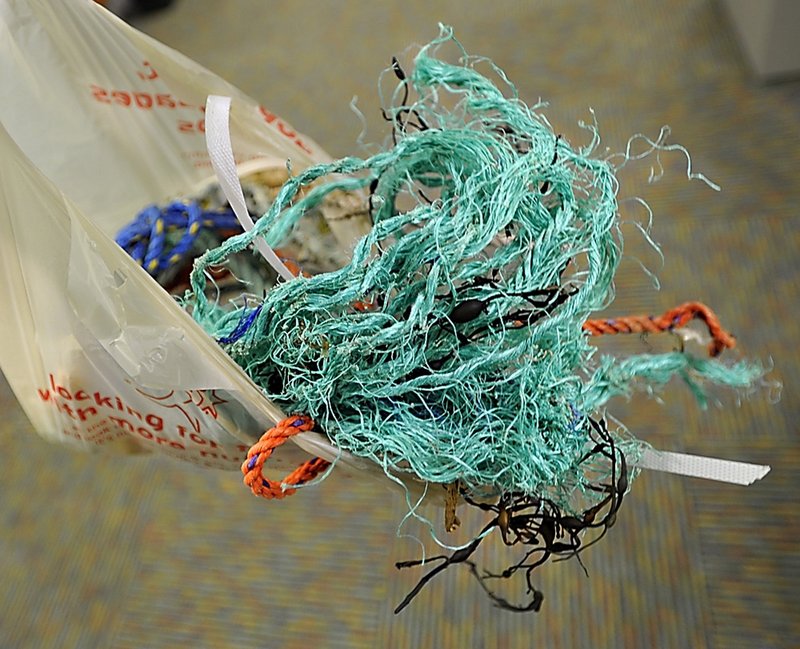BIDDEFORD – Curtis Cove, a deep, horseshoe-shaped nook, lies at the southern tip of this city’s coastline. There, gentle waters lap against pebbles and fine gray sand.
Rocky tide pools teem with life. Beach roses bloom among the rip-rap. It’s protected space, set aside as vital habitat for great annual seabird migrations.
Unmolested, untouristed, supposedly free from the modern world.
Yet the modern world swirls in on every tide.
Along the wrack line, the eye catches them. Little flecks of unnatural green or bright yellow. See one, and you can’t help but see more. A few blue, a white fleck, a red one.
They’re the colors of lobster traps, like those seen stacked in front yards and docks and replicated on postcards. Except these aren’t lobster traps any more. They’re part of what happens when a lobster trap dies.
The Great Pacific Garbage Patch is old news. The Gulf of Maine is its own plastic garbage patch.
Much of our marine litter rolls and bounces along the sea floor, washing up at places like Curtis Cove. That litter includes countless scraps of nonbiodegradable vinyl coating, burst from countless derelict lobster traps rotting on the Gulf of Maine seabed.
I visit the cove weekly, collecting and cataloging what washes in. Along just 150 feet of it, I have collected 10,617 pieces of man-made garbage since late winter.
Of course it isn’t all lobster-trap bits. I have found plant pots, fiberglass siding, a car arm rest, carpet scraps, a saw handle, a crate lid, half of a coathook, part of an outdoor thermometer, even an antique clay pipe.
But sadly, most of what washes up here is directly related to lobstering — 8,076 pieces, 76.1 percent of everything I’ve found: 477 lobster claw bands; 144 trap bumpers; 119 bait bags; and 2,487 fishing rope scraps, eight-tenths of a mile in total length. There are various other scraps of traps, buoys, etc.
And 4,563 flecks of lobster trap vinyl coating.
All from 150 feet of protected cove, in a state with more than 3,000 miles of coastline.
It’s ugly, of course. It’s litter. It shouldn’t be there. But beyond that, plastics in the ocean adsorb terrible toxins. They kill sea life and shore dwellers.
Many of the claw bands (lost overboard as lobsters are being banded) have fish bite marks all over them — possibly from young cunner. The harder vinyl trap coatings could be swallowed whole, tear an animal up and survive intact to kill again.
Maine’s Department of Marine Resources licenses 3 million lobster traps each year. How many have been lost? Nobody knows. From the time that the first trap was put into Maine waters all the way up to 2009, DMR kept no record. Now it requires lobstermen to submit a request in order to get replacement tags.
From 2009 to 2011, the agency received about 38,000 requests per year — and traps mean losing gear. That’s reality. When it was biodegradable, it mattered less. But around 1980, vinyl-coated steel traps and plastic bait bags and rope became the gear of choice, because they seemed cheaper, both in cost and effort.
Thirty-plus years at 38,000-plus lost traps a year mean, conservatively, 1 million derelict plastic-coated lobster traps on the sea floor by now.
Of course, a few wash up. Every beach and island has its wrecked traps. Others are grappled and removed by nonprofits, fishermen and volunteers. But most sit hidden in the deep, where they rot and shed their plastic bits over decades.
So, one of the state’s largest industries uses a business model that plans for losing hundreds of tons of nonbiodegradable plastic into the Gulf annually — and offers no mitigation! Industry’s debris is thus our great-grandchildren’s problem.
It’s well past time to drop the myth of “cheap” plastic. Plastic gear’s costs are very insidious and very real. Besides, the frenzied rush of “more, cheaper, more” has proven to benefit very few. And it leaves a growing legacy of dangerous, persistent pollution that washes up all around us.
It’s time to stop, look at the sand at our feet and really see what’s there. We must treat our resources with respect.
We must return to biodegradable gear, demand a fair price for fishing responsibly and promote the industry internationally as a model of a conscientious and sustainable fishery.
Whatever we do today, our descendants will still find scraps of yesterday’s “cheap” fishing gear on their shores and inside their sea life for decades.
But if we change the game now, maybe at least they’ll look back on us and not shake their heads.
Harold Johnson of Saco is a freelance writer and editor whose avocation is studying the effects humans have on the oceanic environment. He can be followed on Twitter @FlotsamDiaries.
Copy the Story Link
Send questions/comments to the editors.



Success. Please wait for the page to reload. If the page does not reload within 5 seconds, please refresh the page.
Enter your email and password to access comments.
Hi, to comment on stories you must . This profile is in addition to your subscription and website login.
Already have a commenting profile? .
Invalid username/password.
Please check your email to confirm and complete your registration.
Only subscribers are eligible to post comments. Please subscribe or login first for digital access. Here’s why.
Use the form below to reset your password. When you've submitted your account email, we will send an email with a reset code.